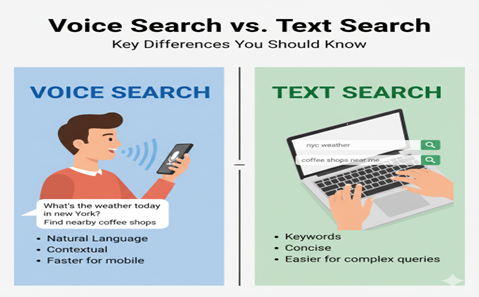Table of Contents
Voice Search vs. Text Search: Key Differences You Should Know
Introduction:
The Future of Search Is Talking Back
In our fast-paced digital age, the way we search for information is changing at lightning speed. With smart assistants like Alexa, Siri, and Google Assistant becoming part of our daily lives, voice search has turned into a go-to method for millions. However, text search still holds strong as the backbone of SEO, especially for those who enjoy diving deep into research or making comparisons.

So, what really sets these two search methods apart and why should marketers pay attention? This article unpacks the main differences between voice search and text search, shedding light on how each one affects SEO and how you can optimize for both.
🧠 Understanding Voice Search

Voice search lets users chat naturally with their devices instead of typing away. It’s hands-free, quick, and seamlessly integrated with mobile tech and AI-driven assistants.
Natural and Conversational: Voice queries feel human like asking, “What’s the best café near me?”
Question-Driven: Most voice searches kick off with who, what, where, or how.
Context-Aware: The results often hinge on your location, the time of day, and your search history.
Recent studies reveal that nearly half of all online searches now involve voice queries. This trend makes optimizing for voice search a must for websites looking to stay ahead.
💻 Understanding Text Search

Text search is still the classic and most commonly used method for finding information online. It’s precise, visual, and ideal for users who prefer to compare various results.
Direct and Focused: Users typically type in short phrases like “best marketing institute near me.”
Result Variety: Search engines showcase a range of links, snippets, and ads for users to explore.
Research-Friendly: Perfect for in-depth reading, comparison, and making informed decisions.
Text search continues to be a powerhouse for SEO. Marketers depend on it to understand user intent, track keywords, and build robust backlink networks.
Attend Our Free Demo Session.
Voice Search vs. Text Search: Side-by-Side Comparison
| Feature | Voice Search | Text Search |
| Query Type | Conversational, question-based | Keyword-focused, concise |
| User Intent | Quick answers, local info | Research, navigation, transactions |
| Result Type | One spoken response or snippet | Multiple results and SERP listings |
| Device Used | Mobile, smart speakers, wearables | Desktop, mobile, tablets |
| SEO Focus | Conversational keywords, local SEO | Keyword density, backlinks, technical SEO |
| User Behavior | Hands-free, natural, fast | Manual, precise, exploratory |
This table clearly shows why brands must optimize for both combining natural, conversational content with keyword-rich technical SEO.
Query Structure and Search Intent
🗣️ Voice Queries Are Longer and Conversational
When people use voice search, they often ask full questions like:
- “What are the best digital marketing courses near me?”
- “How can I make my website more voice search-friendly?”
These longer, more natural phrases help search engines provide direct, conversational answers. By optimizing for question-based content and featured snippets, you can enhance your visibility in voice search.
⌨️ Text Queries Are Short and Targeted
On the other hand, text search users typically type in shorter phrases such as:
- “digital marketing courses Mumbai”
- “SEO tools 2025”
They usually skim through several results before making a choice. This behavior highlights the importance of keyword research, meta optimization, and clear content for success in text searches.
📍 Context and Device Usage
🌐 Voice Search Thrives on Context
Voice search is all about context, including location, timing, and personalization. Queries like “restaurants near me” rely heavily on GPS data. This makes local SEO optimization ensuring accurate business details, schema markup, and Google My Business listings absolutely crucial.
🖥️ Text Search Is Device-Neutral
Text searches can be conducted on any device. Users appreciate the ability to browse multiple options and engage with long-form content. This is where traditional SEO practices — such as strong backlinks, fast site speed, and proper indexing — really shine.
⚙️ How Voice and Text Impact SEO Strategy
🔍 Optimizing for Voice Search
To excel in voice search results, consider these strategies:
- Craft content that sounds conversational and human-like.
- Utilize FAQ formats to address specific “who,” “what,” and “how” questions.
- Aim for featured snippets and “position zero.”
- Enhance local SEO with accurate maps and positive reviews.
- Boost mobile page speed for smooth voice responses.
Optimizing for Text Search
When it comes to typed searches, it’s all about sticking to tried-and-true SEO methods that keep your site authoritative and well-structured:
- Craft titles and headings that are rich in keywords.
- Build a network of high-quality backlinks.
- Fine-tune your meta descriptions and alt tags.
- Ensure your site runs quickly and has a clean layout.
Striking a balance between these elements helps your website maintain a strong ranking across various platforms and devices.
You May Also Like To Read : How to Optimize Content for Generative Search Engines
📈 Impact on Content Creation
Voice search has really changed the game for marketers when it comes to content creation. Instead of cramming in keywords, brands are now focusing on providing genuine answers in a conversational style.
To stay ahead of the curve:
- Use natural language phrases in your blog posts.
- Incorporate Q&A or FAQ sections that feel like real conversations.
- Make sure your design is mobile-first and that you’re using structured data markup for better indexing.
On the other hand, content for text search should remain informative, straightforward, and optimized for keywords catering to users who like to skim through multiple results before making a decision.
🌍 Why a Hybrid Strategy Matters
Both voice and text search have their unique advantages. Voice search is fantastic for quick answers and local results, while text search shines when it comes to research and conversions.
Smart marketers are blending the two by creating content that’s friendly for humans and optimized for algorithms. This hybrid approach guarantees visibility whether users are typing or speaking maximizing traffic, conversions, and overall brand exposure.
✅ Conclusion: Optimize Smart, Rank Everywhere
The conversation isn’t about picking one over the other—it’s about understanding both. Voice search offers convenience, speed, and accessibility, while text search brings depth, accuracy, and the chance to explore.
By embracing a dual SEO strategy, you can:
- Connect with users across different devices and preferences.
- Boost your rankings for both spoken and typed queries.
- Future-proof your online presence against emerging AI and mobile trends.
Ultimately, whether your audience is speaking or typing, your content should always be ready with the right answers.
You May Attend Our Free Demo Session.







